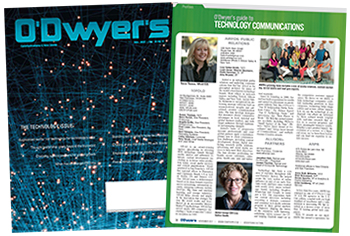|
|
As an experiment, try searching for “PR mistakes” on Google. Rather than finding everyday blunders communications professionals make, a long list of “PR fail” articles fill the page. Obvious snafus like United Airlines’ handling of a passenger who was forcibly removed qualifies as a mistake. But how many companies or their agencies make those types of mistakes? More likely, they’re erring on a much smaller scale. At the end of the day those mistakes add up. And while they might not land a brand on the front cover of USA Today, they may cost that brand valuable relationships and relevance with their key stakeholders. With an eye toward being helpful, here are five common mistakes in Tech PR:
|
|
Targeting the wrong influencers/media professionals.
Every company has “the list.” It often includes 100-250 journalists — many of whom are relevant — but often lacks a rank order beyond the first 5-7 contacts and likely includes targets that were once relevant but have become less so over time. What the list most likely doesn’t include is bloggers or those that run YouTube channels. It probably also doesn’t take into consideration aggregate influence. Back in the day, when a journalist worked for one publication and social media wasn’t yet a thing, it was easy to get a relative sense of whether the aforementioned was important or not. Today, journalists often write for multiple publications, or may keep a personal blog at the very least. They’re also sharing content via Twitter, LinkedIn and SnapChat. This new paradigm creates a new influence that’s hard to measure without the proper tools. In order to solve this problem, our data scientists have created an algorithm that uses 110 different data points to determine a list of the top 50 influencers with weighted ranking. Why is this such a problem? For one, why would you want to spend one second with a journalist that used to be influential but now isn’t in your top 100. And conversely, don’t you want to know who your new and emerging influencers are? What about having the ability to actually groom those with higher signal to noise into top influencers in your space?
Using “impressions” as a performance metric.
Everything these days must be measured. And with PR it’s often been a given that it only drives soft ROI or general awareness for a product, service or brand. But in today’s world, is knowing how many potential eyeballs saw a piece of coverage good enough? If a marketer tried to explain that they’d sent out 100,000 pieces of direct mail and thus had 100,000 impressions but no insights beyond that, they would likely be fired. It’s because the cost of that direct mail campaign would be $25,000-$50,000 thus requiring that the marketer know not only how many responses they received, but how many of those responses turned into leads or even new customers. When the only cost for something is the time it takes to pitch something, the bar for proving effectiveness is set lower. But with companies constantly seeking ways to improve their top and bottom lines, nobody is being allowed to skate. What if PR started to look at number of website visits driven? Or leads generated? Or at the very least, what about positive share of voice in a particular space? The tools exist today to at least show correlation if not causation on all of these fronts so why not use them?
Failing to understand what content resonates with one’s target audience.
It’s probably safe to say that most companies or agencies don’t sit back and say, “I wonder if we can put out a press release that nobody cares about?” But I will guarantee that there are press releases that aren’t optimized for search. There are also pieces of short and long form content that find their way to places like blogs, Twitter and LinkedIn (I see social media as an extension of PR) that use the wrong language or even worse, don’t resonate with target audiences. Given the role that organic search plays in product or brand discovery these days, why not give yourself the best chance of being found? There are numerous tools out there (Google provides some free of charge) that can help optimize content. Or, if you’re really on your game, try running a content gap analysis by comparing search volume for certain key words with keyword density in your owned, earned and social content.
Treating influencers/journalists like order takers.
This means that instead of assuming reporters and bloggers are robots waiting around for the next pitch email or press release to float into their inbox, why not take a step back and look at the challenges these journalists are up against? Many are underpaid, under-resourced and likely under the gun to garner a certain amount of views or social shares for their content. A way to help and build better relationships with these key individuals is by proactively checking in with them and asking them what they are writing about. Share great stories and insights that you’ve heard about that don’t involve your company. Obviously, this can’t be a full time focus, but just like good networking requires “putting money in the bank,” so too does good PR.
Ignoring your employees as a critical channel to share news.
This could be an article unto itself, but employee advocacy is probably one of the greatest untapped resources in the market. Yes, there are risks involved in making sure employees are trained and equipped to share company news. Tools like Dynamic Signal, Social Chorus and LinkedIn’s Elevate make launching, scaling and tracking this activity easier than ever … even in regulated industries.
Are you making these mistakes? Or is your agency? The good news is that they can all be fixed. The solutions just require good data, tools and a little elbow grease.
***
Aaron Strout is Chief Marketing Officer of W2O Group.

 Aaron Strout
Aaron Strout 

 Laura Anderson, who rose to VP/GM of global communications and events in a nearly 20 year stint at Intel, will take on the Americas technology chair at Burson following the completion of the BCW and H+K merger on July 1.
Laura Anderson, who rose to VP/GM of global communications and events in a nearly 20 year stint at Intel, will take on the Americas technology chair at Burson following the completion of the BCW and H+K merger on July 1. WE Communications has partnered with ROKK Solutions to form the WE ROKK AI service.
WE Communications has partnered with ROKK Solutions to form the WE ROKK AI service. In the dynamic world of modern business, effective communication is a pivotal tool for success across various industries. At Communications Strategy Group (CSG®), our expertise in embracing innovation in communication extends beyond traditional marketing strategies, paving the way for transformative industry-specific solutions.
In the dynamic world of modern business, effective communication is a pivotal tool for success across various industries. At Communications Strategy Group (CSG®), our expertise in embracing innovation in communication extends beyond traditional marketing strategies, paving the way for transformative industry-specific solutions. There are two types of tech PR professionals. Which one are you? And are C-suite executives making that decision for you?
There are two types of tech PR professionals. Which one are you? And are C-suite executives making that decision for you? While there’s an impulse to grab reporters’ attention with the newest industry-transforming tech product or service, a back-to-basics approach focused on telling the right stories to the right people is a far more successful way to ensure your technology campaign breaks through the clutter of today’s crowded tech landscape.
While there’s an impulse to grab reporters’ attention with the newest industry-transforming tech product or service, a back-to-basics approach focused on telling the right stories to the right people is a far more successful way to ensure your technology campaign breaks through the clutter of today’s crowded tech landscape.


 Have a comment? Send it to
Have a comment? Send it to 
No comments have been submitted for this story yet.